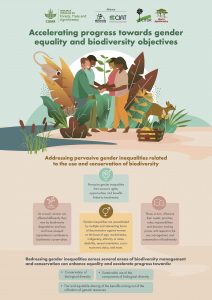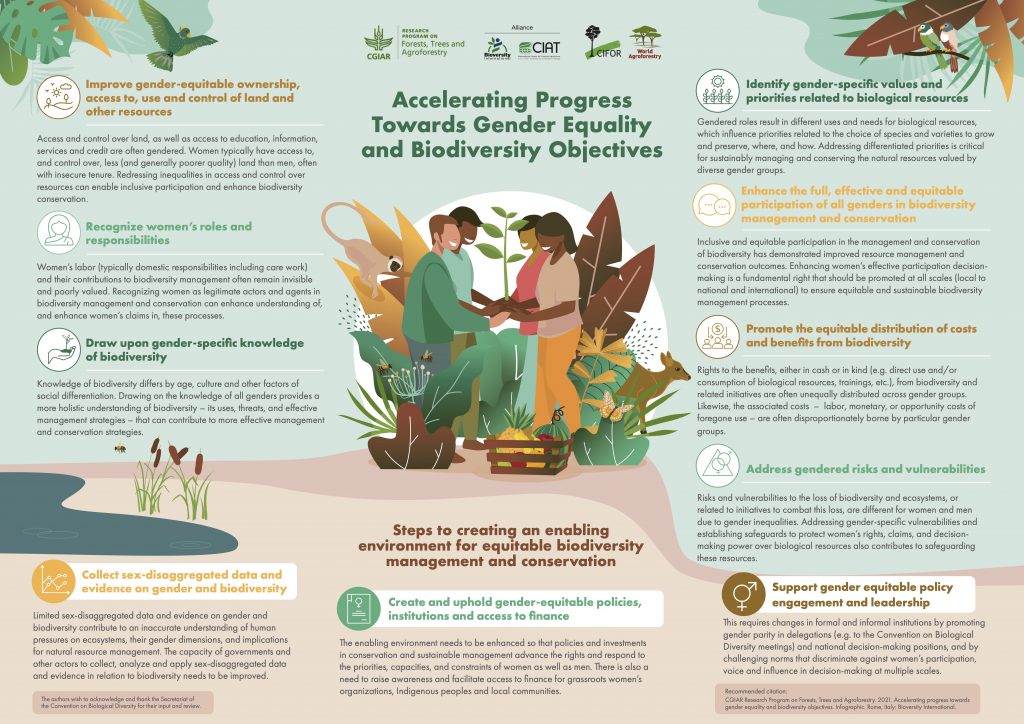As we progress towards establishing a post-2020 Global Biodiversity Framework and approach the halfway mark to the Agenda 2030 Sustainable Development Goals, the social and developmental aspects related to global biodiversity and climate challenges are ever more apparent. Gender dimensions are central to understanding and effectively responding to the world’s most pressing environmental challenges. With a draft Gender Plan of Action proposed for consideration by Parties to the Convention on Biological Diversity (CBD) alongside the post-2020 framework, it is an opportune time to bring attention and resources to ensuring a gender responsive approach to the conservation and sustainable use of biodiversity and the fair and equitable sharing of benefits derived from the utilization of genetic resources.
In the lead up to COP 15, experts from the CGIAR Research Program on Forests, Trees and Agroforestry (FTA), in close collaboration with the Secretariat of the Convention on Biological Diversity, have prepared some guidance on gender and inclusion to support the finalization of the Gender Plan of Action by COP 15, and its implementation in the coming years. An infographic and accompanying brief have been developed to assist Parties and stakeholders engaged in natural resource management, providing an overview of linkages and practical strategies to address pervasive gender inequalities related to the use and conservation of biodiversity.
Informed by the knowledge and experience of diverse stakeholders, the work harnesses ideas and action plans detailed in Addressing Gender Issues and Actions in Biodiversity Objectives – a prominent CBD guide aimed at policymakers and other biodiversity stakeholders – as well as the report Towards a Gender-Responsive Implementation of the Convention on Biological Diversity, published by the CBD Secretariat in advance of COP14, and to which FTA also contributed. These documents emphasise how resolving the challenge of social exclusion is critical for meeting local and global commitments related to restoration, biodiversity and climate change.

Highlighting the link between social identities and discrimination, the infographic and brief demonstrate how multiple intersecting identities (such as age, ethnicity, gender, marital status) have both a direct and indirect influence on the way individuals and groups are recognised, governed and, often, marginalised and discriminated against. Critically, these pieces also demonstrate how intersecting identities define roles, responsibilities and relationships with regard to natural resources and biodiversity restoration and conservation. They highlight the undervalued yet critical role that rural women and girls, Indigenous peoples, and other groups that experience systemic discrimination, play in biodiversity and natural resource management. Accelerating progress towards gender equality and CBD objectives thus requires the recognition of women and Indigenous groups as legitimate players in the use, management, restoration and conservation of biodiversity. It also requires recognizing women, girls and Indigenous peoples as agents of change, and honouring their priorities and capacities.
Enhancing gender equality and social inclusion cannot be achieved without addressing the barriers that exclude social groups, including women and girls, from accessing and controlling land and natural resources, as well as services, such as formal education, finance and information systems, that allow them to manage these resources sustainably and equitably. It further necessitates a fair distribution of biodiversity benefits and costs; the development of safeguards protecting the claims and decision-making powers of rightsholders; the integration of gender-specific knowledge; and the promotion of gender parity and an inclusive environment in national decision-making processes.

As the infographic and brief demonstrate, transforming deep-rooted gender inequalities can support the sustainable use, management, and conservation of biodiversity, and contribute to the fair and equitable sharing of benefits arising from its use. COP15 provides a critical opportunity to integrate these considerations into the post-2020 Global Biodiversity Framework and ensure that clear directions are put forward for progress in the new Gender Plan of Action. As we move into the implementation of the Framework, concrete actions to address gender inequalities are needed on multiple fronts to contribute to real gains for all people and for the planet.











